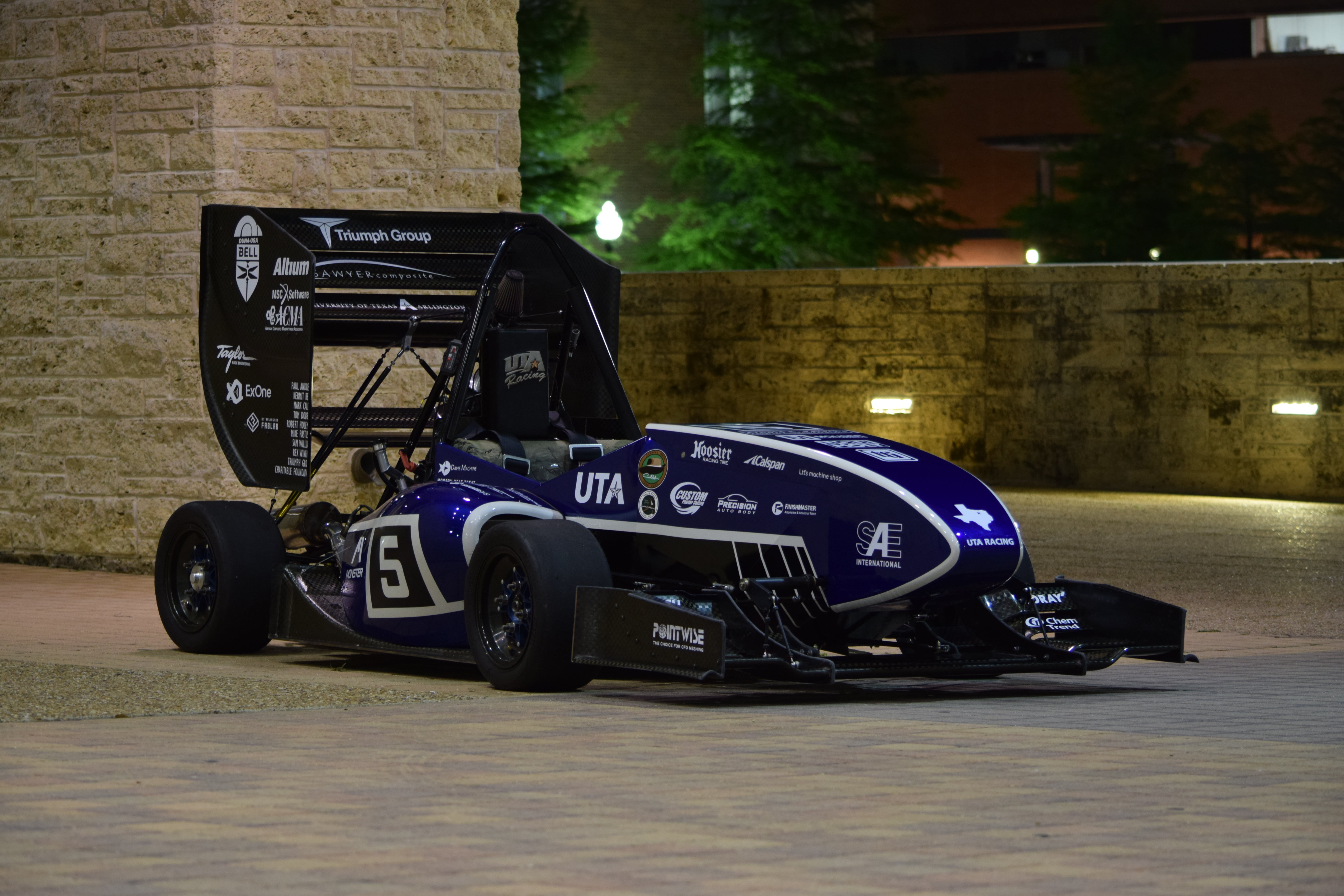UTA Formula SAE team unveils 2019 car
The most decorated university racing team in the United States began its quest for a ninth Formula SAE championship with an unveiling of its 2019 car.
The University of Texas at Arlington has won eight championships in the U.S. and international titles in Great Britain, Australia and Japan in 38 years of competition. Team manager Anirudh Markkassery is confident that this year’s car could take the top spot at the Formula SAE competition in Lincoln, Neb., June 19-22.

“I think this car will be a No. 1 contender. We have a solid team, and this could be our next champion,” Markkassery said.
Each year’s car is a brand-new design, built from the wheels up. This year’s model, under the direction of team captain Chris Dunn, chief engineer Scott Berggren and longtime FSAE adviser and mechanical engineering Professor Bob Woods, was finished in March, giving the engineers and drivers three months to test all of the systems and learn the car’s intricacies on the track.
The extra time for testing is important because major problems can be identified and fixed before the competition. Driver training is also crucial, as being able to drive the actual competition car gives the drivers a better understanding of the car’s tendencies and limitations, such as how it will handle in turns and how the brakes will respond.
“I’m really excited about this car,” said Woods. “We have returned to some design features that have been proven in the past and added new features that should make it really competitive. It was finished early enough to allow this unveiling, plus a lot of track testing and a wind tunnel test. We have high expectations for this car in the U.S. and Australia.”
The team is composed completely of students, mostly from the College of Engineering, but open to all majors. There are about 25 full members and 15 associate members, each assigned to one of nine groups: aerodynamics, composites, drivetrain, electrical, engine, suspension, chassis, ergonomics and data acquisition. Members also generate corporate sponsorships to underwrite the costs of the materials.
“The real-world applications of being part of this team can’t be beat,” said Dunn. “We come up with our concept and decide on our parameters, design the car in CAD and at the end of the year we have a car with amazing technology. You can’t get much more ‘real-world’ than that.”

The car weighs less than 460 pounds. It can accelerate from 0-60 in fewer than three seconds and generates three Gs of lateral force through turns. Over the years, UTA has developed revolutionary designs in engines and fuel injection, as well as an active aerodynamic system with wings in four quadrants that can be adjusted by the driver via an onboard computer to provide optimal downforce for greater handling. The 1992 car featured the first carbon fiber composite wheels in Formula SAE history.
This year, the car was simplified and designed to reduce manufacturing time, but there are still several engineering changes.
“We simplified the car, but still made engineering changes to improve handling and performance,” Berggren said. “We used unsprung aerodynamics, which keeps downforces from compressing the springs, so the front wing moves more favorably during lateral Gs or when the car hits a bump. We improved the efficiency of the front wing because it does more for performance than the other systems on the car. We really invested time in ergonomics to hold the driver in place and make driver inputs easier so the driver is more comfortable and the car is easier to drive.”
UTA began FSAE competition in the Mini Baja class in 1981 and won championships that year and in 1982. The first championship in the Formula class came in 1985, and the team also racked up victories in 1986, 1990, 1991, 1995 and 1996. In addition, the team won the inaugural Formula Student competition in England in 1998, Formula SAE Australasia in Australia in 2000 and Formula SAE Japan in 2004.
In 2012, a $1 million endowment by Arlington businessman Arnold E. Petsche, matched through the University’s Maverick Match program, established the Arnold E. Petsche Center for Automotive Engineering, which is located on the first floor of Woolf Hall and houses a showroom for several of the team’s cars, plus meeting and work spaces.
In 2014, UTA was ranked No. 5 in the world and No. 1 in the United States in the Formula Student Combustion World Rankings.
“Our racing teams have shown a consistent level of excellence for more than three decades, and they have been leaders in innovation the entire time,” said Peter Crouch, dean of the College of Engineering. “Their contributions to Formula SAE, in particular the guidance of Bob Woods, are unmatched, and the experience gained by students during their time with the team positions them to be top candidates with industry-leading companies worldwide.”